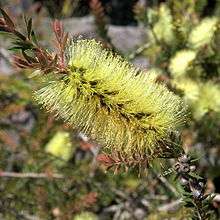Melaleuca virens
Melaleuca virens, commonly known as lime bottlebrush, is a plant in the myrtle family, Myrtaceae and is endemic to Tasmania in Australia. (Some Australian state herbaria continue to use the name Callistemon viridiflorus.)[2] It is one of only two melaleucas endemic to Tasmania, the other being Melaleuca pustulata although another six also occur there. A small to medium shrub growing mostly in subalpine areas, it has hard, leathery, sharply pointed leaves and spikes of yellow or greenish flowers in early summer,
| Lime bottlebrush | |
|---|---|
 | |
| M. virens flowers, fruit and new growth | |
| Scientific classification | |
| Kingdom: | Plantae |
| Clade: | Tracheophytes |
| Clade: | Angiosperms |
| Clade: | Eudicots |
| Clade: | Rosids |
| Order: | Myrtales |
| Family: | Myrtaceae |
| Genus: | Melaleuca |
| Species: | M. virens |
| Binomial name | |
| Melaleuca virens | |
| Synonyms[1] | |
| |
Description
Melaleuca virens is a shrub growing to 3 m (10 ft) tall. Its leaves are arranged alternately and are 14–37 mm (0.6–1 in) long, 1.8–5 mm (0.07–0.2 in) wide, flat, elliptic to lance-shaped, sometimes slightly curved and taper to a sharp point. The side-veins are indistinct but the mid-vein and oil glands are visible on both surfaces.[3][4][5]
The flowers are a shade of yellow to greenish-yellow and are arranged in spikes on the ends of branches which continue to grow after flowering and also on the sides of the branches. The spikes are 30–50 mm (1–2 in) in diameter and 40–60 mm (1.6–2.4 in) long with 20 to 80 individual flowers. The petals are 2.7–4.9 mm (0.1–0.2 in) long and fall off as the flower ages and there are 19-36 stamens in each flower, sometimes arranged in 5 groups. Flowering occurs from November to May and is followed by fruit which are woody capsules, 4.5–6 mm (0.18–0.24 in) long.[3][5]
Taxonomy and naming
Lime bottlebrush was first described in 1825 by John Sims from a specimen raised by seed in Fulham nursery. The description was published in Curtis's Botanical Magazine.[6][7] In 1826 Sweet changed the name to Callistemon viridiflorus, publishing the change in Hortus Britannicus [8][9] and in 2006, Lyndley Craven changed the name to Melaleuca virens.[10][11] That name has been accepted by the World Checklist of Selected Plant Families but not by the Australian Plant Census.[1][12]
The specific epithet (virens) is from the Latin word viridis meaning “green”[13] referring to the flower colour of this species.[3]
Distribution and habitat
Melaleuca virens occurs throughout Tasmania but is more common in wet places in mountain or colder areas of the state.[3][5] It grows in swamps, in heath and on buttongrass plains.[3]
References
- "Melaleuca virens". World Checklist of Selected Plant Families (WCSP). Royal Botanic Gardens, Kew.
- Udovicic, Frank; Spencer, Roger (2012). "New combinations in Callistemon (Myrtaceae)" (PDF). Muelleria. 30 (1): 23–25. Retrieved 21 July 2015.
- Brophy, Joseph J.; Craven, Lyndley A.; Doran, John C. (2013). Melaleucas : their botany, essential oils and uses. Canberra: Australian Centre for International Agricultural Research. p. 384. ISBN 9781922137517.
- Jordan, Greg. "Melaleuca virens". University of Tasmania. Retrieved 21 July 2015.
- "Plants for special places". Hobart District Group of The Australian Plants Society - Tasmania Inc. Retrieved 21 July 2015.
- "Metrosideros viridiflora". APNI. Retrieved 22 July 2015.
- Sims, John (1825). Curtis's Botanical Magazine (Volume 52). London: Sherwood, Jones & Co. p. 2602. Retrieved 22 July 2015.
- "Callistemon viridiflorus". APNI. Retrieved 22 July 2015.
- Sweet, Robert (1826). Hortus Britannicus (1 ed.). Piccadilly: James Ridgway. p. 155. Retrieved 22 July 2015.
- "Melaleuca virens". APNI. Retrieved 22 July 2015.
- Craven, Lyn A. (2006). "New Combinations in Melaleuca for Australian Species of Callistemon (Myrtaceae)". Novon. 16 (4): 473.
- "Callistemon viridiflorus". Australian Plant Census. Retrieved 4 May 2019.
- Brown, Roland Wilbur (1956). The Composition of Scientific Words. Washington, D.C.: Smithsonian Institution Press. p. 383.